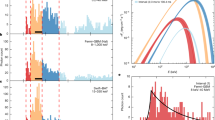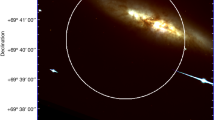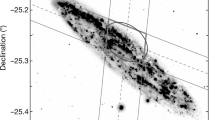Abstract
Magnetars are strongly magnetized, isolated neutron stars1,2,3 with magnetic fields up to around 1015 gauss, luminosities of approximately 1031–1036 ergs per second and rotation periods of about 0.3–12.0 s. Very energetic giant flares from galactic magnetars (peak luminosities of 1044–1047 ergs per second, lasting approximately 0.1 s) have been detected in hard X-rays and soft γ-rays4, and only one has been detected from outside our galaxy5. During such giant flares, quasi-periodic oscillations (QPOs) with low (less than 150 hertz) and high (greater than 500 hertz) frequencies have been observed6,7,8,9, but their statistical significance has been questioned10. High-frequency QPOs have been seen only during the tail phase of the flare9. Here we report the observation of two broad QPOs at approximately 2,132 hertz and 4,250 hertz in the main peak of a giant γ-ray flare11 in the direction of the NGC 253 galaxy12,13,14,15,16,17, disappearing after 3.5 milliseconds. The flare was detected on 15 April 2020 by the Atmosphere–Space Interactions Monitor instrument18,19 aboard the International Space Station, which was the only instrument that recorded the main burst phase (0.8–3.2 milliseconds) in the full energy range (50 × 103 to 40 × 106 electronvolts) without suffering from saturation effects such as deadtime and pile-up. Along with sudden spectral variations, these extremely high-frequency oscillations in the burst peak are a crucial component that will aid our understanding of magnetar giant flares.
This is a preview of subscription content, access via your institution
Access options
Access Nature and 54 other Nature Portfolio journals
Get Nature+, our best-value online-access subscription
$29.99 / 30 days
cancel any time
Subscribe to this journal
Receive 51 print issues and online access
$199.00 per year
only $3.90 per issue
Buy this article
- Purchase on Springer Link
- Instant access to full article PDF
Prices may be subject to local taxes which are calculated during checkout



Similar content being viewed by others
Data availability
The ASIM data used for this study are available on the Zenodo repository, https://doi.org/10.5281/zenodo.5242975. The Swift 100-μs-resolution data are publicly available at the Swift BAT GUANO repository: https://www.swift.psu.edu/guano. The Fermi NaI and BGO data are publicly available at https://heasarc.gsfc.nasa.gov/W3Browse/fermi/fermigbrst.html.
Code availability
For the search for QPOs within the Bayesian framework, we use the Stingray Python Package developed by Huppenkothen et al.30 (https://docs.stingray.science). The Z2 search and related calculations of confidence level and chance probabilities are performed using Interactive Data Language (IDL) version 8.7.3. The IDL codes developed can be provided upon request. For spectral analysis we used the software XSPEC, version v12.10.1f, (including the XANADU package) available at https://heasarc.gsfc.nasa.gov/xanadu/xspec/.
References
Kaspi, V. M. & Beloborodov, A. M. Magnetars. Annu. Rev. Astron. Astrophys. 55, 261–301 (2017).
Mereghetti, S., Pons, J. A. & Melatos, A. Magnetars: properties, origin and evolution. Space Sci. Rev. 191, 315–338 (2015).
Duncan, R. C. & Thompson, C. Formation of very strongly magnetized neutron stars: implications for gamma-ray bursts. Astrophys. J. 392, L9–L13 (1992).
Mazets, E. P., Golenetskii, S. V., Il’inskii, V. N., Aptekar’, R. L. & Guryan, Yu. A. Observations of a flaring X-ray pulsar in Dorado. Nature 282, 587–589 (1979).
Ofek, E. O. et al. The short-hard GRB 051103: observations and implications for its nature. Astrophys. J. 652, 507–511 (2006).
Barat, C. et al. Fine time structure in the 1979 March 5 gamma ray burst. Astron. Astrophys. 126, 400–402 (1983).
Strohmayer, T. E. & Watts, A. L. Discovery of fast X-ray oscillations during the 1998 giant flare from SGR 1900+14. Astrophys. J. Lett. 632, L111–L114 (2005).
Israel, G. L. et al. The discovery of rapid X-ray oscillations in the tail of the SGR 1806-20 hyperflare. Astrophys. J. 628, L53–L56 (2005).
Strohmayer, T. E. & Watts, A. L. The 2004 hyper flare from SGR 1806-20: further evidence for global torsional vibrations. Astrophys. J. 653, 593–601 (2006).
Pumpe, D., Gabler, M., Steininger, T. & Enβlin, T. A. Search for quasi-periodic signals in magnetar giant flares – Bayesian inspection of SGR 1806-20 and SGR 1900+14. Astron. Astrophys. 610, A61 (2018).
Marisaldi, M., Mezentsev, A., Østgaard, N., Reglero, V. & Neubert, T. GRB 200415A: ASIM observation. GCN Circular 27622 (2020).
Svinkin, D. et al. A bright γ-ray flare interpreted as a giant magnetar flare in NGC 253. Nature 589, 211–213 (2021).
Roberts, O. R. et al. Rapid variability of a giant flare from a magnetar in NGC 253. Nature 589, 207–210 (2021).
The Fermi-LAT Collaboration. High-energy emission from a magnetar giant flare in the Sculptor galaxy. Nat. Astron. 5, 385–391 (2021).
Yang, J. et al. GRB 200415A: a short gamma-ray burst from a magnetar giant flare? Astrophys. J. 899, 106 (2020).
Zhang, H. M., Liu, R.-Y., Zhong, S.-Q. & Wang, X.-Y. Magnetar giant flare origin for GRB 200415A inferred from a new scaling relation. Astrophys. J. Lett. 903, 32 (2020).
Burns, E. et al. Identification of a local sample of gamma-ray bursts consistent with a magnetar giant flare origin. Astrophys. J. Lett. 907, 28 (2021).
Neubert, T. et al. The ASIM mission on the International Space Station. Space Sci. Rev. 215, 26 (2019).
Østgaard, N. et al. The Modular X- and Gamma-Ray Sensor (MXGS) of the ASIM payload on the International Space Station. Space Sci. Rev. 215, 23 (2019).
Leahy, D. A. et al. On searches for pulsed emission with application to four globular cluster X-ray sources: NGC 1851, 6441, 6624 and 6712. Astrophys. J. 266, L160–L170 (1983).
Buccheri, R. et al. Search for pulsed γ-ray emission from radio pulsars in the COS-B data. Astron. Astrophys. 128, 245–251 (1983).
Gehrels, N. et al. The Swift gamma-ray burst mission. AAstrophys. J. 611, 1005 (2004).
Barthelmy, S. D. et al. The Burst Alert Telescope on the Swift Midex mission. Space Sci. Rev. 120, 143–164 (2005).
Tohuvavohu, A. et al. Gamma-Ray Urgent Archiver for Novel Opportunities (GUANO): Swift/BAT event data dumps on demand to enable sensitive subthreshold GRB searches. AAstrophys. J. 900, 35 (2020).
Mahlmann, J. F., Akgün, T., Pons, J. A., Aloy, M. A. & Cerdá-Durán, P. Instability of twisted magnetar magnetospheres. Mon. Not. R. Astron. Soc. 490, 4858–4876 (2019).
Parfrey, K., Beloborodov, A. M. & Hui, L. Twisting, reconnecting magnetospheres and magnetar spindown. Astrophys. J. Lett. 754, 12 (2012).
Li, X., Zrake, J. & Beloborodov, A. M. Dissipation of Alfvén waves in relativistic magnetospheres of magnetars. Astrophys. J. 881, 13 (2019).
Duncan, R. C. Global seismic oscillations in soft gamma repeaters. Astrophys. J. 498, L45–L49 (1998).
Gabler, M., Cerdá-Durán, P., Stergioulas, N., Font, J. A. & Müller, E. Constraining properties of high-density matter in neutron stars with magneto-elastic oscillations. Mon. Not. R. Astron. Soc. 476, 4199–4212 (2018).
Chanrion, O. et al. The Modular Multispectral Imaging Array (MMIA) of the ASIM payload on the International Space Station. Space Sci. Rev. 215, 28 (2019).
Vaughan, S. A Bayesian test for periodic signals in red noise. Mon. Not. R. Astron. Soc. 402, 307–320 (2010).
Huppenkothen, D. et al. Quasi-periodic oscillations and broadband variability in short magnetar bursts. Astrophys. J. 768, 87 (2013).
Huppenkothen, D. et al. Stingray: a modern Python library for spectral timing. Astrophys. J. 881, 39 (2019).
McDermott, P. N., van Horn, H. M. & Hansen, C. J. Nonradial oscillations of neutron stars. Astrophys. J. 325, 725–748 (1988).
Vaughan, S. A simple test for periodic signals in red noise. Astron. Astrophys. 431, 391–403 (2005).
Sotani, H., Kokkotas, K. D. & Stergioulas, N. Torsional oscillations of relativistic stars with dipole magnetic fields. Mon. Not. R. Astron. Soc. 375, 261–277 (2007).
Brazier, K. T. S. Confidence intervals from the Rayleigh test. Mon. Not. R. Astron. Soc. 268, 709–712 (1994).
Timokhin, A. N., Eichler, D. & Lubarsky, Yu. On the nature of quasi-periodic oscillations in the tail of soft gamma repeater giant flares. Astrophys. J. 680, 1398–1404 (2008).
Gabler, M., Cerdá-Durán, P., Stergioulas, N., Font, J. A. & Müller, E. Modulating the magnetosphere of magnetars by internal magneto-elastic oscillations. Mon. Not. R. Astron. Soc. 443, 1416–1424 (2014).
Gabler, M. et al. Magneto-elastic oscillations modulating the emission of magnetars. Astron. Nachr. 338, 1105–1108 (2017).
Watts, A. L. & Strohmayer, T. E. Detection with RHESSI of high-frequency X-ray oscillations in the tail of the 2004 hyperflare from SGR 1806-20. Astrophys. J. 637, L117–L120 (2006).
Huppenkothen, D., Heil, L. M., Watts, A. L. & Göğüş, E. Quasi-periodic oscillations in short recurring bursts of magnetars SGR 1806-20 and SGR 1900+14 observed with RXTE. Astrophys. J. 795, 114 (2014).
Miller, M. C., Chirenti, C. & Strohmayer, T. E. On the persistence of QPOs during the SGR 1806-20 giant flare. Astrophys. J. 871, 95 (2019).
Steiner, A. W. & Watts, A. L. Constraints on neutron star crusts from oscillations in giant flares. Phys. Rev. Lett. 103, 181101 (2009).
Carrasco, F., Viganò, D., Palenzuela, C. & Pons, J. A. Triggering magnetar outbursts in 3D force-free simulations. Mon. Not. R. Astron. Soc. 484, L124–L129 (2019).
Li, X. & Beloborodov, A. M. Plastic damping of Alfvén waves in magnetar flares and delayed afterglow emission. Astrophys. J. 815, 25 (2015).
Thompson, C. & Duncan, R. C. The giant flare of 1998 August 27 from SGR 1900+14. II. Radiative mechanism and physical constraints on the source. Astrophys. J. 561, 980–1005 (2001).
Acknowledgements
This work made use of data from ASIM. ASIM is an international experiment aboard the International Space Station. ASIM is a mission of the European Space Agency (ESA), funded by ESA and national grants from Denmark, Norway and Spain. ESA PRODEX contracts C 4000115884 (DTU) and 4000123438 (Bergen) support the ASIM Science Data Centre. The science analysis is supported by ESA Topical Team contract 4200019920/06/NL/VJ; European Research Council grant AdG-FP7/2007-2013: n 320839; Research Council of Norway contract 223252/F50 (CoE/BCSS); and Ministerio de Ciencia, Innovación y Universidades grants ESP 2017-86263-C4 and ESP2017-87676-C5-5-R. J.A.F. and P.C.-D. acknowledge support by the Spanish Agencia Estatal de Investigación (grant PGC2018-095984-B-I00) and by the Generalitat Valenciana (PROMETEO/2019/071). P.C.-D. acknowledges the Ramon y Cajal funding (RYC-2015-19074) for supporting his research. M.G. acknowledges support through the Generalitat Valenciana via the grant CIDEGENT/2019/031. A.J.C.-T., J.P.-G., M.D.C.-G. and E.R. acknowledge financial support from the State Agency for Research of the Spanish MCIU through the “Center of Excellence Severo Ochoa” award to the Instituto de Astrofísica de Andalucía (SEV-2017-0709). This work is partly based on observations made with the Gran Telescopio Canarias (GTC), installed at the Spanish Observatorio del Roque de los Muchachos of the Instituto de Astrofísica de Canarias, on the island of La Palma. We thank J. D. Scargle for his help with the preliminary time-series analysis and his comments. J.P.-G. also acknowledges funding support from Spanish public funds for research from project PID2019-107061GB-C63 from the ‘Programas Estatales de Generación de Conocimiento y Fortalecimiento Científico y Tecnológico del Sistema de I+D+i y de I+D+i Orientada a los Retos de la Sociedad’ from the Spanish Ministry of Science, Innovation and Universities (MCIU).
Author information
Authors and Affiliations
Contributions
A.J.C.-T., N.Ø. and V.R. led the research team for this event. V.R., J.N.-G., N.Ø. and T.N. contributed to ASIM and provided the raw ASIM data. A.M., M.M., N.Ø., A.L. and V.R. provided the data for the time analysis. E.G., C.S.-G., J.P.-G. and E.R. analysed the time variability in the data. A.L. and C.A.O. provided the spectral accepted data. B.-B.Z. and Z.-K.P. performed the preliminary spectral analysis and M.M. performed the detailed spectral analysis. I.K. and C.B.-J. contributed to all ASIM phases for the MXGS development. A.L. and D.S. verified the LED and HED energy-response matrices. D.S. provided the calibration of the HED instrument and also performed the calculations of column density and potential photon absorption in the atmosphere. F.C., C.J.E., G.G., K.U. and S.Y. contributed substantially to the design, building and operation of the ASIM MXGS instrument. I.M.C.-G., M.A.C.T., E.F.-G., C.P.d.P., S. G. and A.J.R.T. provided the optical data. P.C.-D., M.G. and J.A.F. contributed to the theoretical interpretation of the observational results. A.J.C.-T., N.Ø., E.G., C.S.-G., M.G. and J.P.-G. contributed to the writing of the manuscript. All the co-authors, including S.B., M.D.C.-G., A.C., M.A.C.T., P.C.-D., J.A.F., M.G., Y.-D.H., I.K., N.L., A.N.G., S.B.P., R.S.-R. and T.S., have read the manuscript and made useful suggestions.
Corresponding authors
Ethics declarations
Competing interests
The authors declare no competing interests.
Additional information
Publisher’s note Springer Nature remains neutral with regard to jurisdictional claims in published maps and institutional affiliations.
Extended data figures and tables
Extended Data Fig. 1 Optical content of the final Inter-Planetary Network (IPN) error box12 (red parallelogram) partly including the NGC 253 galaxy.
a, A 120-s exposure (clear filter) taken by the BOOTES-1A wide field camera in Huelva (South Spain) on 23 July 2020 (04:00 ut). The field of view is 0.5° × 0.5°. This field was just 1.84° above the Earth’s limb as seen by ASIM. b, A magnification fo the IPN error box showing a colour image resulting from the combination of g (10 s), r (5 s) and i (5 s) -band exposures taken by the 10.4-m Gran Telescopio Canarias on 16 August 2020, 04:30 ut.
Extended Data Fig. 3 Time-resolved spectroscopy (including residuals).
Spectra for four time intervals during the magnetar giant flare, defined in the main text. a, Precursor: 0.0–0.8 ms. b, Peak: 0.8–3.2 ms. c, Decay: 3.2–8 ms. d, Tail: 8–160 ms. A total number of 2,148 counts in the LED and 2,141 counts in the HED have been used. Left panels: count spectra (blue: LED; red: HED) and best-fit models (green). Middle panels: residuals. Best-fit models are those highlighted in bold in Table 1. Right panels: energy flux density for the best-fit models.
Extended Data Fig. 5 Periodograms and residuals of the LED light curves for time periods from 0-5, 0-10, 0-50 and 0-100 ms after the burst (t = 0 is start of the burst), with a time resolution of 50 μs (frequency bins of 200 Hz).
a, Unsmoothed (black) and smoothed (orange; Wiener filter, 3Δν) periodograms. Power-law fit in blue, and power law plus two Lorentzians (centred around the 2,100 and 4,200 Hz features) fit in red. b, The residuals of the fits around the 2,100 Hz feature. c, The residuals of the fits around the 4,200 Hz feature.
Extended Data Fig. 6 Periodograms and residuals of the HED light curves for time periods from 0-5, 0-10, 0-50 and 0-100 ms after the burst (t = 0 is start of the burst), with a time resolution of 50 μs (frequency bins of 200 Hz).
a, Unsmoothed (black) and smoothed (orange; Wiener filter, 3Δν) periodograms. Power-law fit in blue, and power law plus two Lorentzians (centred around the 2,100 and 4,200 Hz features) fit in red. b, The residuals of the fits around the 2,100 Hz feature. c, The residuals of the fits around the 4,200 Hz feature.
Extended Data Fig. 7 \({{\boldsymbol{Z}}}_{{\bf{1}}}^{{\bf{2}}}\) power spectra in the 300-5,000 Hz frequency range, obtained with the events within the first 5 ms time interval of the burst.
a, Using LED data. b, Using HED data. The horizontal dotted, dashed and solid lines represent 95%, 99% and 99.9% confidence levels, respectively.
Extended Data Fig. 8 A spectrogram combined of consecutive periodograms for ASIM-LED, 50-400 keV, with 200 ms long sliding window, and 1 ms step.
Time axis corresponds to the left edge of the sliding window. a, Covering the interval between −300 ms and +300 ms relative to the GRB onset. Colour bar represents the Leahy-normalized PSD, where 2 corresponds to the white noise level. Areas of interest are highlighted with the red rectangles and are shown in the next panels for frequency range 1 kHz to 5 kHz. b, Zoomed-in segment of the spectrogram when the sliding window just enters the GRB region. A higher time resolution of 10 µs steps is used. For convenience time axis corresponds to the right edge of the 200-ms long sliding window, relative to the GRB onset. c, Zoomed-in segment of the spectrogram when the sliding window starts to leave the GRB region. Time axis corresponds to the left edge of the 200-ms long sliding window, relative to the GRB onset.
Rights and permissions
About this article
Cite this article
Castro-Tirado, A.J., Østgaard, N., Göǧüş, E. et al. Very-high-frequency oscillations in the main peak of a magnetar giant flare. Nature 600, 621–624 (2021). https://doi.org/10.1038/s41586-021-04101-1
Received:
Accepted:
Published:
Issue Date:
DOI: https://doi.org/10.1038/s41586-021-04101-1
This article is cited by
-
Tracking transients night and day
Nature Astronomy (2023)
Comments
By submitting a comment you agree to abide by our Terms and Community Guidelines. If you find something abusive or that does not comply with our terms or guidelines please flag it as inappropriate.



